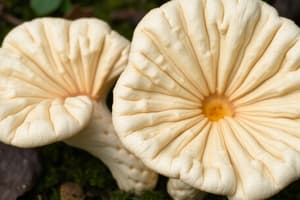Podcast
Questions and Answers
Which of the following are included in the Deuteromycetes?
Which of the following are included in the Deuteromycetes?
- Animal parasites (correct)
- Plant pathogens (correct)
- Industrially important forms like Penicillium (correct)
- None of the above
What type of reproduction do mitosporic fungi or anamorph display?
What type of reproduction do mitosporic fungi or anamorph display?
Asexual reproduction
What arises from the coenocytic mycelium in Zygomycota?
What arises from the coenocytic mycelium in Zygomycota?
- Sporangiophores (correct)
- Hyphal structure
- Conidia
- Columella
What are conidia?
What are conidia?
What factors are considered in Deuteromycetes classification?
What factors are considered in Deuteromycetes classification?
The importance of a classification scheme is so each person will know what the other is talking about.
The importance of a classification scheme is so each person will know what the other is talking about.
Flashcards are hidden until you start studying
Study Notes
Deuteromycetes Overview
- Ecologically and economically significant group of fungi.
- Includes animal parasites and common soil saprophytes, aiding in decomposition and mineral recycling.
- Many are destructive plant pathogens; some can affect both plants and animals.
- Industrially relevant species include Penicillium and Aspergillus, utilized for citric acid, hormones, and steroids.
- Destructive saprophytes contribute to food and grain spoilage.
Asexual Reproduction
- Known as mitosporic fungi or anamorphs, lacking a known sexual stage in their life cycle.
Zygomycota Characteristics
- Sporangiophores develop from coenocytic mycelium; hyphal tip enlarges to form sporangium.
- Contains a sterile supporting structure called the columella.
- Spores, known as sporangiospores, are generated internally and released by the rupture or breakdown of the sporangial wall.
Conidia Details
- Asexual reproductive structures called conidia (singular: conidium), meaning dust in Greek.
- Produced by conidiogenous cells or conidiophores, which are specialized hyphae.
- A single colony or species can produce two types of conidia: macroconidia (larger) and microconidia (smaller).
Classification of Deuteromycetes
- Classification based on specific characteristics of isolates, including:
- Colonial color
- Consistency and topography of colonies
- Reverse pigmentation
- Types of conidia or spore formation
- Hyphal structure
Importance of Classification
- Enables clear communication among researchers and academics regarding specific fungal species and strains.
- Essential for patent descriptions and furthering knowledge on particular species.
Studying That Suits You
Use AI to generate personalized quizzes and flashcards to suit your learning preferences.


